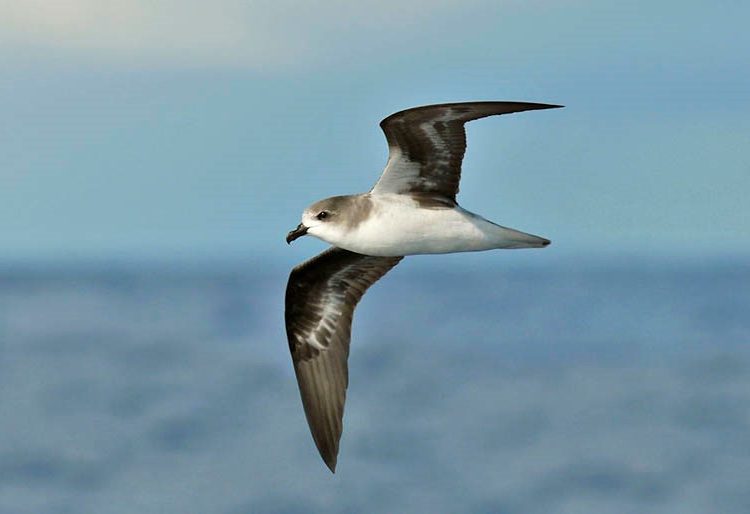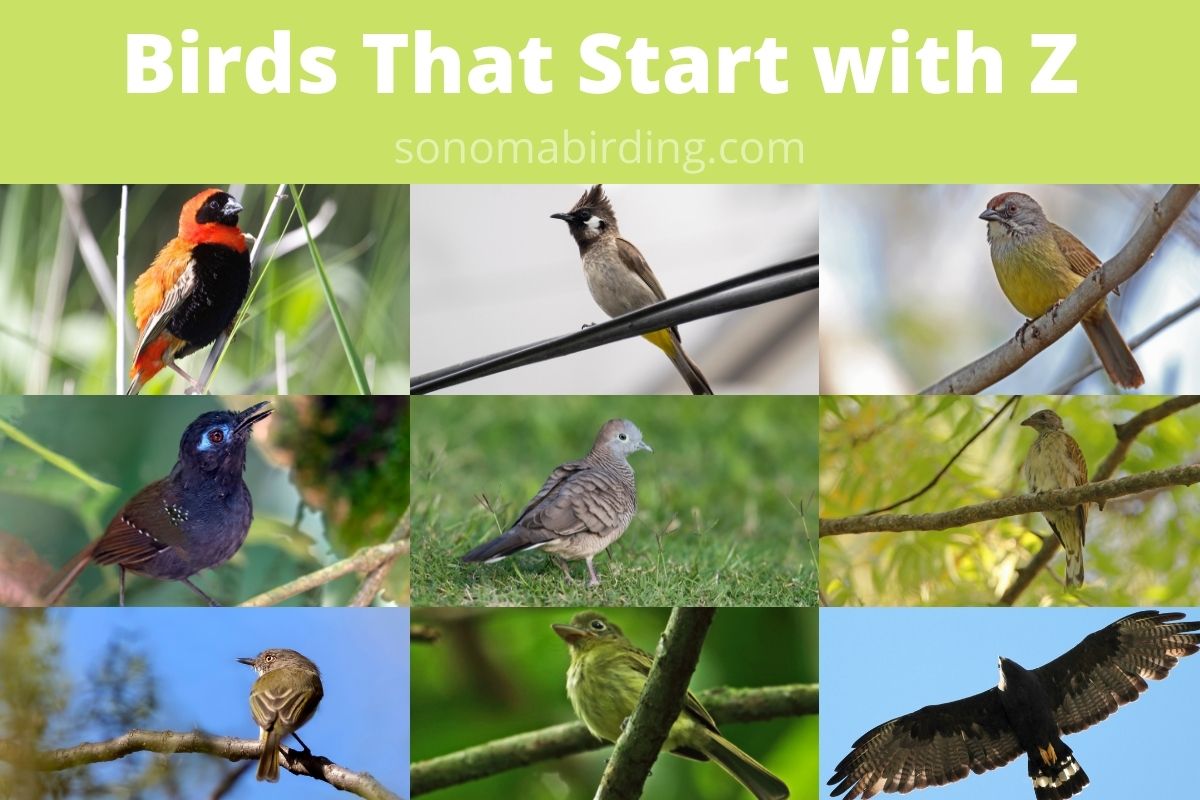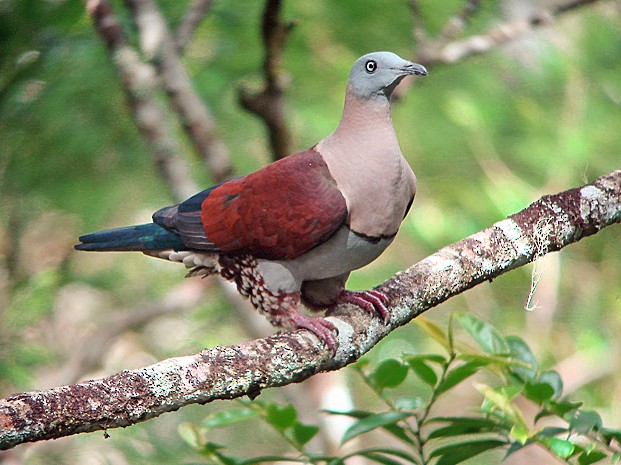Birds are beautiful creatures with an amazing variety of colors, songs, and behaviors at their disposal. They fly with the wind in their feathers, soar with happiness when they find food, and mate with the most beautiful bird in the flock. They also have some pretty unusual characteristics. No two birds look alike. Feathers come in a dazzling array of colors ranging from iridescent greens to dazzling blues and black. But did you know what all birds start with the letter Z?
Here goes the list of birds that start with the letter Z. This list can be very useful for ornithologists and bird lovers in general in learning and understanding the variety and types in this group of birds.
Zanzibar Red Bishop (Euplectes nigroventis)
Named after the island they’re endemic to, Zanzibar Red Bishops are a weaver species found in East Africa. These birds primarily inhabit moist areas, marshes, flooded grasslands, and cultivated areas; their range often overlaps with the Black-winged Bishops.
The adult Zanzibar Red Bishops are sexually dimorphic, with the breeding males appearing different from the non-breeding males and females.
The breeding males are colored in bright orange and black. While their head and upper parts are orange, the underbody is black in contrast, except for a bold orange breast band.
On the other hand, the non-breeding males and females have a dull brown, streaky plumage. They lack both the breast band and the luster of the breeding males. Zanzibar Red Bishops have a short, typically rough call that sounds like “tek tek tek.”
Zappey’s Flycatcher (Cyanoptila cumatiis)
Initially believed to be a subspecies of the Blue-and-white Flycatchers, the Zappey’s Flycatchers are an Old World Flycatcher family found in China, the Malay Peninsula, and the islands of Indonesia.
The IUCN has declared these flycatchers to be a Near-threatened species. They’re migratory in nature, breeding in evergreen and submontane forests; there’s little info about their wintering grounds.
The adult Zappey’s Flycatchers are sexually dimorphic, with the breeding males appearing significantly different from the non-breeding males and females. They have a bright blue head, breast, and back, with dark rufous edges to their wings and tail.
On the other hand, the females and non-breeding males have a grey head and upper back, with bluish wings and tails that are not as bright as the breeding males. All birds have white undersides, dark eyes, feet, legs, and a short, dark bill.
Zebra Finch (Taeniopygia guttata)
Zebra Finches are one of the most widespread estrildid finch species that are endemic to Australia. These birds initially occurred only on Timor Island and are now found in Portugal and Puerto Rico as an introduced species.
Zebra Finches have two recognized subspecies and display sexual dimorphism in their plumage. The males have a grey head and white underparts, with a bold black color on their front, extending to their flanks. Their wings and tail are also grey with dark edges.
On the other hand, their female counterparts lack the black markings and possess a grey head, back, and white underbody. Both sexes have a bright orange bill and a dark stripe running under their eyes. The males also have orange cheek patches, which are absent in females.
Zebra Finches have an average lifespan of five years in the wild but can survive up to twelve years under proper care and nourishment. Grass seeds, both ripe and semi-ripe, are a staple diet for these birds.
Zapata Wren (Ferminia cerverai)
The Zapata Wrens are a monotypic member of their genus. These have been named after the Zapata Swamp in Cuba, where they are native to and have an abundant population.
Their habitat is typically in the freshwater marsh and the lowland savanna with low trees and scattered bushes. They have an endangered population, with habitat destruction (due to forest fires and increasing agricultural practices) and introduced predation being the major threats to their species.
Zapata Wrens are medium-sized birds with an overall greyish-brown plumage. They are quite long-tailed for a wren, with their underparts being primarily stripped with black and grey. They have dark eyes, a grey bill curving downward at the tip, and greyish legs and feet.
Both sexes of the adult Zapata Wrens appear similar, displaying minimal sexual dimorphism in plumage and size. Their song is quite similar to that of the House Wrens, being significantly loud and high-pitched.
Zambezi Indigobird (Vidua Codrington)

Named after the Zambezi River in Africa, the Zambezi Indigobirds are an African indigobird species. These birds prefer to inhabit moist woodlands, forest edges, and cultivation lands. They’re also referred to as “Green Indigobird” and “Twinspot Indigobird.”
Zambezi Indigobirds are strongly sexually dimorphic, with the breeding males having a different plumage than the non-breeding males and females.
In the breeding season, the males have an overall black plumage with a greenish gloss over it. Their eyes are dark, while the bill, legs, and feet are orangish in shade.
Outside of the breeding season, the males appear brownish, with heavy streaking across their body and a grey breast band. The songs of Zambezi Indigobirds are a mixture of squeaky notes and fast trills.
Zamboanga Bulbul (Hypsipetes rufigularis)

Zamboanga Bulbuls are tiny songbirds in the Bulbul family that have been named after their nativity to the Zamboanga Peninsula. The IUCN has declared these birds to be Near-threatened species, with habitat loss taking a severe toll on their declining population.
Zamboanga Bulbuls primarily inhabit tropical or subtropical moist lowlands, with both sexes appearing identical in size and plumage.
They closely resemble the Yellow-wattled Bulbuls but lack their bright yellow eye-rings. The adults have a dark, greyish brown crown and wings, with a dull rufous breast patch and pale, whitish undersides.
Zamboanga Bulbuls are highly vocal birds that produce a loud and fast “Picha picha picha” call.
Zapata Rail (Cyanolimnas cerverai)

Endemic to the Zapata Swamp of Cuba, Zapata Rails are medium-sized members of the rail family. These birds inhabit flooded vegetation, bush-covered swamps, and low trees.
The IUCN has declared their species to be Critically Endangered. These birds are evolving to become weak fliers or flightless altogether, which is why they’re increasingly vulnerable to predators.
The adult Zapata Rails have an olive-brown forehead and upper part. Both sides of their head and underparts are slate-grey, with slight barring on their lower belly. These birds have grey-brown flanks and white undertail.
Zapata Rails have short and rounded wings. Their irises, feet, and legs are red-colored while the bill is yellow, with a reddish base. These birds lack any sexual dimorphism, with the sexes appearing similar in both size and plumage.
All adults produce a bouncy call similar to that of Bare-legged Owls, sounding like “cutucutu-cutucutu-cutucutu.” They mostly feed on invertebrates and plant materials.
Zapata Sparrow (Torreornis inexpectata)
Zapata Sparrows are a medium-sized New World Sparrow species that inhabit the grasslands of Zapata Swamp, Cuba. Their species has a vulnerable population that is sensitive to habitat destruction and increased tourism.
Zapata Sparrows have a medium-sized body that is mainly greyish-yellow in color. Their upperparts are olive-grey, with a whitish breast and pale-yellow belly and rump.
These birds also have a dark, reddish-brown crown atop their head. Both sexes have identical plumage and are sexually monomorphic in nature.
Other than feeding on flowers, Zapata Sparrows also eat small insects, spiders, snails, and lizards. Their songs are a mixture of high-pitched trills and quiet trills.
Zenaida Dove (Zenaida aurita)
Also referred to as “Turtle Dove,” the Zenaida Doves are a small pigeon species that are found throughout the Caribbean. They are declared as the national bird of Anguilla.
They’re a resident species within their range, much like the other members of the Columbidae family. They’re often hunted as gamebirds, which has now become a major threat to their population.
Zenaida Doves closely resemble the Mourning Doves in appearance but display a darker coloration. They have a compact body colored in an orangish-brown shade, with a short, rounded tail. Their wings have a white edge which is clearly visible in flight.
Zenaida Doves mainly forage on the ground and feed on seeds, grains, and occasionally insects.
Zeledon’s Antbird (Percnostola zeledoni)
Named in the memory of Jose Castulo Zeledon, the Zeledon’s Antbirds are found in the humid forests of Central and South America. These birds have two recognized subspecies.
The adult Zeledon’s Antbirds are strongly sexually dimorphic, with the males possessing a fully black plumage and their female counterparts displaying a dark brown body. Females also have a dark head and black edges to their wings and tail.
Both sexes have unique pale blue skin around their dark eyes, along with a dark grey, pointed bill. These birds mainly feed on insects.
Zarudny’s Sparrow (Passer zarudnyi)
Also referred to as the “Asian Desert Sparrow,” Zarudny’s Sparrows are a small, pallid sparrow species found in Uzbekistan and Turkmenistan. These birds inhabit the arid, sandy areas, and desert bushes, and scrubs within their range.
They were initially considered a subspecies of Desert Sparrows but are now treated as an individual species.
The adult Zarudny’s Sparrows display no sexual dimorphism. Both sexes have a small body with a grey head and upper parts. They have black eye masks and chin patches, white-patched wings, and a sandy-colored underbody.
Zebra Dove (Geopelia striata)
Also known as “Barred Ground Doves,” the Zebra Doves are a dove species endemic to Southeast Asia. These doves primarily inhabit scrubs, lowland areas, farmlands, and urban areas and are also found in Hawaiian Islands, Mauritius, Indonesian islands, and French Polynesia.
The adult Zebra Doves are sexually monomorphic, with both sexes appearing identical externally. They have a small body with a relatively long tail. Their face appears faintly bluish-grey, with brownish-grey upper body and pale pink undersides.
Their belly, neck, and breast are covered in black streaks, with black and white spots on their back. These birds primarily feed on weed seeds and grasses but will also forage for ground insects occasionally.
Zimmer’s Woodcreeper (Dendroplex kienerii)
Zimmer’s Woodcreepers are a South American woodcreeper species that inhabit the seasonally flooded forests and basins. These birds are considered a Near-threatened species by the IUCN.
Zimmer’s Woodcreepers closely resemble the Straight-billed Woodcreepers in appearance, except for their slower songs and a thicker bill. They possess a slender body with a relatively long tail.
Their body is mainly covered in rufous-brown, with heavy white markings around their face.
There’s very little data about the sexual dimorphism displayed by these birds, which is why the sexes are often considered monomorphic.
Zenker’s Honeyguide (Melignomon zenkeri)

Named after Georg Zenker, a German botanist, the Zenker’s Honeyguides are an indicator bird species endemic to Africa’s Central and Western parts. They inhabit forest edges and other low elevation areas.
Zenker’s Honeyguides are sexually monomorphic in nature. Both sexes have olive-green upper parts and pale green underparts. Their vent is heavily streaked, with shiny green wings and a black-tipped tail.
Zigzag Heron (Zebrilus undulatus)
The Zigzag Herons are a monotypic member of their genus. These herons are endemic to South America and can be found in the Amazon Basin of the Andes, Bolivia, Brazil, Colombia, and Peru. They live in swamps, grass borders of pools, lakes, and forested rivers.
Zigzag Herons are small herons with mainly dark grey plumage. Both sexes of these birds are sexually monomorphic. They have a brown upper part, buff white specks, and dusky flight feathers.
Adults have a mottled-grey head, pale underparts covered in zigzag barring. They have a short black bill, yellow eyes, and greyish-yellow legs.
Zimmer’s Tody-tyrant (Hemitriccus minimus)
The Zimmer’s Tody-tyrants are a South American tyrant flycatcher species that are named after John Todd Zimmer, the American Naturalist.
These birds are also called “Zimmer’s Bamboo Tyrants” and breed in subtropical dry bushy areas, white-sand forests, and other poor-quality soil areas.
Zimmer’s Tody-tyrants have an olive-green plumage, with dusky streaks scattered all over. They have yellow wing bars, a long thin bill, and yellow eye-rings. Both sexes of these birds appear identical.
Zimmer’s Flatbill (Tolmomyias assimilis)
Also referred to as the “Yellow-margined Flatbill,” the Zimmer’s Flatbills are a tyrant flycatcher species found in Central and South America. Their natural habitats include humid forests, Chocó, and edges.
These birds closely resemble the Yellow-olive Flatbills in appearance and have a grey head, back, and breast, with yellow underparts. Their wings and tail are edged with black, with a grey bill and dark eyes.
Zimmer’s Tapaculo (Scytalopus zimmeri)
Named after John Todd Zimmer, the Zimmer’s Tapaculos are a tiny South American Tapaculo species mainly found in Bolivia and Argentina. These birdies mostly inhabit rocky slopes, vegetative communities, and wooded ravines.
Both sexes of Zimmer’s Tapaculos have the same plumage; only the males are heavier than their female counterparts. They have a white head, throat, and breast, with a brown back and wings. Their lower belly is colored in a buff shade, with a slender, black bill and olive-brown flanks.
Zino’s Petrel (Pterodroma madeira)

Named after the British ornithologist Paul Alexander Zino, the Zino’s Petrels are a seabird species native to the Madeira Islands.
These petrels have a slender, medium-sized body with relatively long wings and tails. They have a rounded head, a short bill, white underparts, a grey hood, breast, and upper parts. Due to a restrictive range, their species is endangered.
Zone-tailed Hawk (Buteo albonotatus)
Zone-tailed Hawks are a hawk species that inhabit the dry and warm parts of the Americas. These raptors prefer to inhabit river woodlands, desert mountains, riparian cottonwood forests, and mountain pine forests.
Zone-tailed Hawks show sexual dimorphism in size, with the females being bulkier and heavier than their male counterparts. They are greyish-black overall with a white-spotted breast and face, a black silver-banded tail, yellow legs, long wings, a white-spotted breast, and a white face.
Zoe’s Imperial Pigeon (Ducula zoeae)
Also referred to as “Banded Imperial Pigeon,” the Zoe’s Imperial Pigeons are found in New Guinea. They primarily inhabit tropical or subtropical forests, mangroves, and humid montane forests.
Both sexes of Zoe’s Imperial Pigeons are identical in appearance, displaying sexual monomorphism. They have yellow eyes, a grey head, and a green tail. Their irises are white, feet red, and bill grey.
These birds have a pink breast with a black band on it, chestnut wing coverts, and a white belly.
Zitting Cisticola (Cisticola juncidis)
Also known as “Streaked Fantail Warbler,” the Zitting Cisticolas are an Old World Warbler species with a widespread distribution throughout Southern Europe, Asia, Africa, and Northern Australia. These warblers live near the water on grasslands, agricultural areas, and meadows.
The adult Zitting Cisticolas are sexually monomorphic. Both sexes have a buff face, a medium-sized body with a broad, white-tipped tail. Their rump is reddish-brown, with pink legs and feet.
These birds have black marks on their brown upper parts with sandy underparts. Both their bill and crown are dark-colored.
Conclusion: Birds That Start With Z
That brings us to the end of our article. I hope you’ve enjoyed learning more about the things you can do to improve your bird watching experience, and that you’re inspired to go out more often.
I’m sure you’re thrilled to have read everything you just did and if you could share this page with your friends (so they too could expand their bird knowledge too!) that would be great.
As always, I want to find new ways to be useful for my readers, so if you have anything in mind, let me know via the contact page, and I’ll see what I can do!
Birds By Alphabet (A-Z List)
Birds that Start with A
Birds that Start with B
Birds that Start with C
Birds that Start with D
Birds that Start with E
Birds that Start with F
Birds that Start with G
Birds that Start with H
Birds that Start with I
Birds that Start with J
Birds that Start with K
Birds that Start with L
Birds that Start with M
Birds that Start with N
Birds that Start with O
Birds that Start with P
Birds that Start with Q
Birds that Start with R
Birds that Start with S
Birds that Start with T
Birds that Start with U
Birds that Start with V
Birds that Start with W
Birds that Start with X
Birds that Start with Y
Birds that Start with Z
















